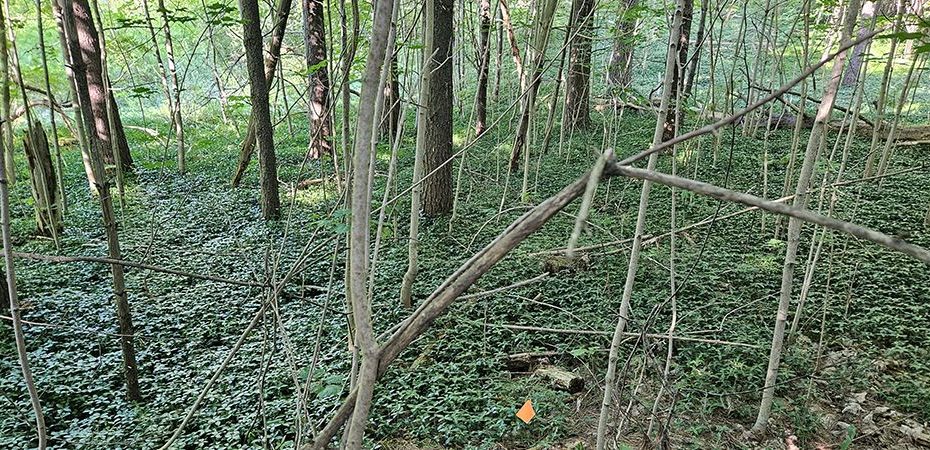After a decade-long run, Ontario is making some timely adjustments to the provincial Invasive Species Strategic Plan (2012). To guide updates to the plan, the government invited the public to provide their vision for the future of invasive species prevention and management in Ontario.
We did just that, incorporating feedback from 19 of our Nature Network member groups.
Periwinkle, Cawthra Mulock Nature Reserve © Melissa Thomas
Invasive species are increasingly a cause of grave concern. They represent one of the five leading contributors to alarming rates of biodiversity loss, and their impacts are amplified by pressures from climate change and habitat loss.
Our top five recommendations for the new invasive species strategy are the following:
Continue building upon collaborative, respectful relationships with Indigenous Peoples, rightsholders, partners, and communities. Indigenous Peoples have deeply embedded rights and responsibilities towards ancestral and contemporary territories. We support ongoing efforts to include differing Knowledge Systems and diverse understandings of invasive species during planning and management processes.
Invasive species workshop, Ontario Nature Youth Summit © Daynan Lepore
Prioritize prevention strategies. Prevention is understood as the most effective pathway for controlling and mitigating the spread and impacts of invasive species. Prevention measures require cooperation and coordination across all levels of government, the private sector, Indigenous Peoples and communities, and the public towards a whole-of-society approach. If prevention is no longer possible, we suggest prioritizing early detection and rapid response measures, particularly in large, connected systems like the Great Lakes where eradication is more challenging.
Hemlock wooly adelgid © Stephanie Muckle
Secure funding opportunities for locally oriented prevention strategies. Funding for management (for example, grants to purchase equipment for invasive species removals) is often more available than funding for longer-term solutions, such as prevention strategies. We recommend that funding opportunities reflect the urgent need for the development and implementation of prevention strategies locally to improve efficiency and outcomes.
Periwinkle © Robert Sproule
Improve regulations to restrict the sale of invasive ornamental species sold at nurseries and garden centres: Many invasive species are still widely available for purchase and are becoming a major focus of management efforts for nature organizations across the province. We recommend the province continue regulating sales of invasive species while increasing large-scale public awareness of their impacts.
Provide leadership to increase local, provincial, national, and international collaboration on invasive species efforts. Consistent provincial oversight on prevention and early detection measures can provide much-needed direction at local and regional scales. Additionally, as Canada is a signatory to the 2022 Kunming-Montreal Global Biodiversity Framework, Ontario’s invasive species strategy should align with Target 6 of the international framework which aims to “reduce the introduction of invasive species by 50% and minimize their impact” by 2030.
Grass carp (invasive) and eastern spiny softshell turtle (endangered species) © Noah Cole
We applaud Ontario’s leadership in invasive species prevention and management to-date, including the development of the Invasive Species Act, 2015. However, with evolving pressures from climate change and relentless urbanization, the future of a biodiverse planet remains precarious. We envision a future where Ontario prioritizes local prevention strategies with ample funding opportunities, coordinates efforts across jurisdictions, cultures, and partners, and aligns the province’s renewed strategy with national and international targets.
Resources
The post Our Vision for the New Invasive Species Strategy in Ontario appeared first on Ontario Nature.
